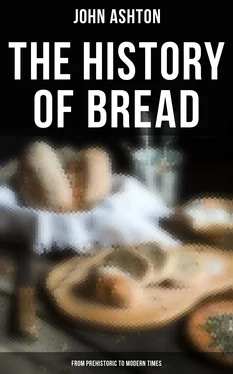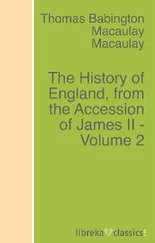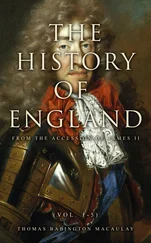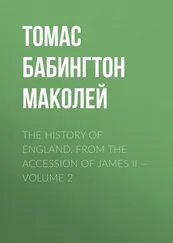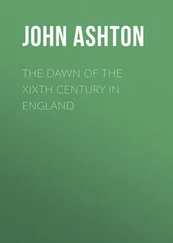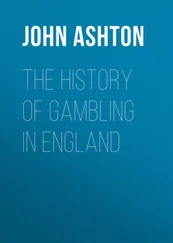
Pre-Historic Mills and Corn-Crushers.
To these mealing-stones succeeded the quern. This was a basin, or hollowed stone, with another—oviform—for grinding. The quern has survived to this day. In London, at the west end of Cheapside, by Paternoster Row, was a church, destroyed by the Great Fire of 1666, and never rebuilt, called St. Michael le Quern. It was close by Panyer Alley, so called from the baker’s basket, and a stone is still in the alley on which is sculptured a naked boy sitting on a panyer. Querns have been found in the remains of the lake dwellings in Switzerland, and in the Crannoges, or lake dwellings of Scotland and Ireland. They are still in use in out-of-the-way places in Norway, in remote districts in Ireland, and some parts of the western islands of Scotland. In the latter country, as early as 1284, an effort was made by the Legislature to supersede the quern by the water-mill, the use of the former being prohibited, except in case of storm, or where there was a lack of mills of the new species. Whoever used the quern was to ’gif the threttein measure as multer2;’ and the transgressor was to ‘time3 his hand mylnes perpetuallie.’ Querns were not always made of stone, for one made of oak was found in 1831, whilst removing Blair Drummond Moss. It is 19 in. in height by 14 in. in diameter, and the centre is hollowed about a foot, so as to form a mortar.
To sum up this notice of pre-historic bread, I may mention that at Robenhausen, Meisskomer discovered 8lbs. weight of bread, and also at Wangen has been found baked bread or cake made of crushed corn exactly similar. Of course, it has been burnt, or charred, and thus these interesting specimens have been preserved to the present day. The form of these cakes is somewhat round, and about an inch to an inch and a half thick; one small specimen, nearly perfect, is about four or five inches in diameter. The dough did not consist of meal, but of grains of corn more or less crushed. In some specimens the halves of grains of barley are plainly discernible. The under side of these cakes is sometimes flat, sometimes concave, and there appears no doubt that the mass of dough was baked by being laid on hot stones, and covered over with glowing ashes.
CHAPTER II.
CORN IN EGYPT AND ASSYRIA.
Table of Contents
The ancient Egyptians had as cereals three kinds of wheat— Triticum sativa , zea and spelta ; barley, Hordeum vulgare , and doura, Holcus sorghum , specimens of which may be seen in the Egyptian Gallery at the British Museum. The so-called ‘mummy-wheat’ is a fallacy, as far as its name goes; it is the Triticum turgidum compositum , cultivated in Egypt, Abyssinia, and elsewhere.
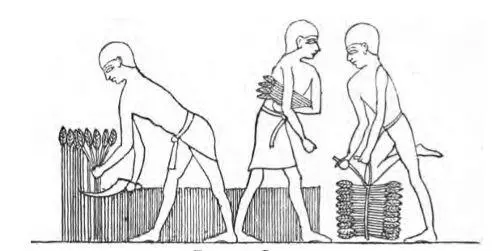
Egyptian Reapers.
In this fertile land the cultivation of corn was very primitive; the sower had his seed in a basket, which he held in his left hand, or suspended it either on his arm or by a strap round his neck, and he threw the seed broadcast with his right hand. According to the paintings in the tombs, he immediately followed the plough, the light earth needing no further treatment, and the harrow, in any form, was unknown. Wheat was cut in about five months after planting, and barley in about four. We have here a representation of harvesting, showing the reaping, with the length of stubble left, and its being tied up into sheaves, or rather bundles. We next see the bundles being made into pyramidal stacks.

Egyptians Stacking Corn.
Here it remained until it was required for threshing, and then it was transported to the threshing floor in wicker baskets, upon asses, or in rope nets borne by two men. These threshing floors were circular level plots of land, near the field, or in the vicinity of the granary; and, the floor being well swept, the ears were laid down and oxen driven over it in order to tread out the grain, which was swept up by an attendant.
And, like their modern brethren, they were merry at their work and sang songs, several of which may be seen in the sculptured tombs of Upper Egypt. Champollion gives the following, found in a tomb at Eileithyia:
‘Thresh for yourselves (twice repeated),
O oxen,
Thresh for yourselves (twice repeated);
Measures for yourselves,
Measures for your masters.’
Sometimes the cattle were bound by their horns to a piece of wood, which compelled them to move in unison, and tread the corn regularly. But it was also threshed out by manual labour, with curious implements. The next operation was to winnow the corn, which was done with wooden shovels; it was then carried to the granary in sacks, each containing a certain quantity, which was determined by wooden measures, a scribe noting down the number as called by the tellers, who superintended its removal. Herodotus (book II., 14) says that the Egyptians trod out their corn by means of swine.
Besides the growing and gathering of wheat, the doura is also represented in paintings in tombs at Thebes, Eileithyia, Beni-Hassan, and Saggára. Both it and wheat are represented as growing in the same field, but the doura is the taller of the two. It was not reaped, but was pulled up by the roots by men, and sometimes women, who struck off the earth which adhered with their hands, bound it in sheaves, and carried it to a place where it was rippled, as flax is done.

Egyptians Threshing.

Egyptians Carrying Grain to the Threshing Floor.
In the ordinary life of the Egyptians, the woman mealed the flour—in as primitive a form as the prehistoric man—and in the British Museum are two wooden models, which show the first process of converting the cereal into meal; and then we have two figures of men kneading dough—from the Museum at Ghizeh (formerly at Boulak). The bread itself was both leavened and unleavened—as may be seen by the many examples—round, triangular, and square—in the British Museum, some of which must have been a foot across, and over an inch thick; the three examples given on page 27 being 5in. in diameter, and ½in. thick; 7 ditto and ½ ditto; whilst the ornamented cake is 3–½in. in diameter and ¾in. thick.
But there were professional bakers in Egypt, as we see in some of the tomb-pictures. In the Biblical story of Joseph we find that ‘the butler of the King of Egypt and his baker had offended their lord the King of Egypt’; and the Rabbi Solomon says their offences were the butler not having perceived a fly in Pharaoh’s cup, and the baker having got a stone into the royal bread, so that Pharaoh thought they were conspiring against his life. We know they were put in prison with Joseph, and related their dreams to him. The dream of the Opheh, or chief baker, was that he ‘had three white baskets on his head, and in the uppermost basket there was all manner of bake meats for Pharaoh.’ The Bible story of Joseph goes on to tell us how, in the years of plenty, he providentially stored up the excess of corn to meet the years of famine, and how the Israelites sent to Egypt for food, and subsequently abode in that land.
Читать дальше
